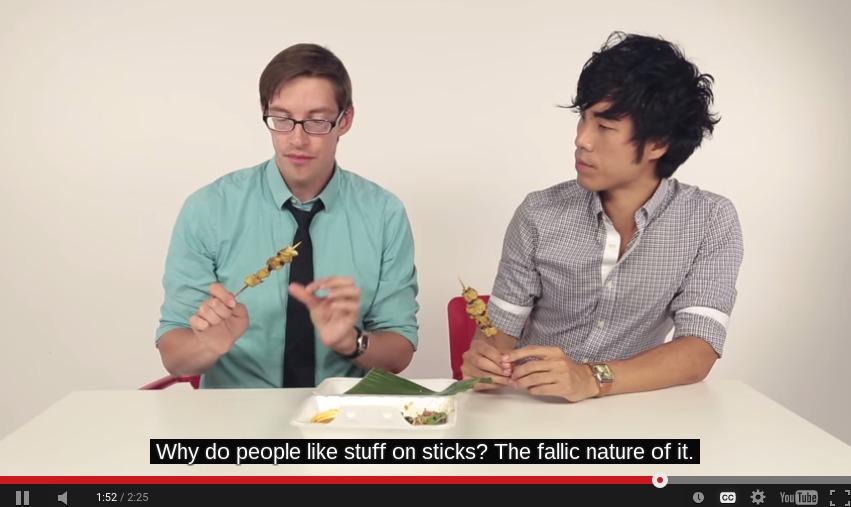What’s Eating Youtube?: Food Commodity Content Online
Die Ashley
The video for ‘Cake crush,’ posted to Youtube by user felicity barclay, begins with a shot of chocolate sponge cake, lightly dusted with powdered sugar, on a tile floor. A woman’s high heel looms in the frame. She (presumably felicity) drives her heel into the cake, creating puncture wounds. She drags it around on the tile. She steps into the cake. This move is destructive, climactic: the “crush.” She changes out her heels for a new pair, and the process begins again.

‘Cake crush,’ as part of the crushing paraphilia, exemplifies one of numerous genres of user-generated food-commodity content on Youtube. Others include taste tests, calorie challenge videos, first-person confessionals, and other fetish videos. In taste tests, the user tries various foods, usually thematic (e.g. British Girl Tries American Candy) and records his or her reactions; in calorie challenge videos, the user attempts to consume a specified amount of calories in a specified timeframe (e.g. 10K Calorie Food Challenge) First-person confessionals and/or food diaries, find the user either recording his or her eating throughout the day (e.g. Full Day of Eating | Macros & Flexible Dieting), or enumerating what was eaten (e.g. Over 5000 calories in one day...Binge eating disorder); fetish videos mostly commonly exhibit crushing, bellystuffing/ overeating, and feederism. In any case, consumption is made conspicuous, exhibitionist; consumption is abstracted from what it is to eat and interact with food as food, and that is pivotal. This media, and the audience demand for it, exploits, normalizes, and reifies the larger aestheticization, sponsorship, and cultural/erotic interest in the commodity form and in disordered eating.
Conspicuous consumption is traditionally defined in terms of power and mobility demonstrated in the “keeping up with the Joneses” formula of conferring social status through capital accumulation. The contemporary phenomenon of consumption, however, is abstract. Marx first wrote of commodity fetishism in Capital: Critique of Political Economy (1867), stating that “the commodity-form, and the value-relation of the products of labor within which it appears, have absolutely no connection with the physical nature of the commodity and the material relations arising out of this.” ‘Cake crush’ exemplifies the Marxian commodity fetish as it appears in the more recently defined, gestural crush fetish/ paraphilia genre. The cake fetish is located in the intact commodity-form that is destroyed in the “crush.” The abstraction of capital precedes this, originating with production, but, in this stage of global capitalism, commodity fetishism becomes commodity eroticization.
Food and sex were arguably conflated in Augustinian theology: the apple, or biblical fruit, becomes synonymous with The Fall of Man, the eroticized original sin. Now it is secularized: “food porn” is vernacular for a new type of commodity-fetishism media. Marx’s understanding of the fetish derives from research on cult worship; fetish in the religious context refers to the displacement of the power of the abstract onto an object, such as an icon. As he writes, “[T]he products of the human brain appear as autonomous figures endowed with a life of their own.” The symbolic value of “food” proceeds from phenomena like artificial scarcity, the “limiting of the production of goods and services that would otherwise be plentiful and inexpensive,” as a means of maintaining the exchange value of the commodity form. Branding serves this function too. A corporation like Dunkin’ Donuts, for instance, would sell more donuts if they lowered their prices; they make more money, however, by keeping their prices the same and throwing away donuts, thereby upholding the exchange value of the brand. This method of distribution relies upon the abstract power of commodity and the creation of actual waste.

Buzzfeed Leftovers Taste Test
The Youtube food-commodity genres reference this through tropes like fast food-themed challenges and “grocery hauls” featuring identifiable brands and product placement. Additionally, Youtube monetizes its user-generated media, so these well-established genres all feed into corporate content cycles. Youtube is structured for native advertising: it renders any and all of its users to individual brands, broadcasting themselves to undifferentiated audiences. Buzzfeed “taste tests” are in competition for views and subscribers with the above-mentioned “British Girl”; VICE’s “Sex+Food” series competes with sex workers. 10,000+ calorie challenges appear in the “Related Videos” sidebar for reality TV clips on food addiction, for binge/ purge confessionals, for amateur bellystuffing videos.

Buzzfeed Taste Test
Commodity fetishism is also gendered. The aestheticization of disordered eating/eating disorder supports this for how the affliction is, statistically and culturally, feminized. Women in this subculture participate in conspicuous eating that is disordered, and that is either presented as recreational and/or normalized (e.g. Girl vs. 10,000 Calories), or, when acknowledged as disordered, shameful (e.g. Confessions of a Binge Eater). The latter perhaps harkens back to the Augustinian apple symbology, as Eve is often conflated with the Fall. Both forms of participation are sexually commodifiable. The participation of male users in similar or even the same media (e.g. a man “taste testing” alongside a woman in a Buzzfeed video) does not change this. (It is important to note that the users making confessional and fetish videos are overwhelmingly women.) Female users in all of these videos perform the same conspicuous, disordered action: it is always the interaction of the sexual object and the commodity-form which is fetishized.
Prior to even being fetishized, patriarchy regulates women’s food intake as part of a general regime of biological control. When men develop their subjective and/or erotic relationship to women vis à vis their interactions with food and with food as a commodity-form, it is necessarily in relation to patriarchal ideology. The fetish of feederism is a salient example, for how female “feedees” can be coerced by male “feeders” to gain weight. This is why so many food and eating fetishes replicate heterosexualized, ritualized submission: fetishes for overeating (the “subcultural”) and undereating are comparable, because they are both predicated on incapacitating the women.

Women Laughing Alone With Salad.
The Hairpin
Laughing Alone With Salad. Maja Cule. DIS images.
Perhaps it logically follows that the personification of “food porn” could precipitate similar gendered identifications to pornography. As a viewer with the social experience of feminization and sexual commodification -- including the eating disorders and the socialized “pathological fear of becoming fat,” as the DSM5 describes–I find myself involuntarily identifying with the women in this media. This compulsion to identify speaks to how subculture is oftentimes a reflection, or recapitulation, of dominant ideology. ~*
Die Ashley is...